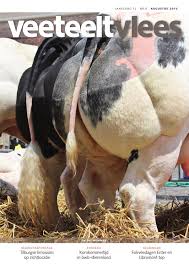There are quite a few concepts used in butchers and meat nursery to calculate and compare the efficiency at different feeding schedules and meat processing. It is juggled kilograms, percentages and conversions. You would therefore assume that there is a clear, almost scientific basis and an objective standard for this. Not so.
 Of terms, there are hardly any (identical) definitions to be found. They are used interchangeably and unambiguously defined anywhere. Moreover, they are interpreted differently in different sub-sectors (e.g. calves versus pigs or chickens).
Of terms, there are hardly any (identical) definitions to be found. They are used interchangeably and unambiguously defined anywhere. Moreover, they are interpreted differently in different sub-sectors (e.g. calves versus pigs or chickens).
The concept carcass is defined in dictionaries and encyclopedias, ranging from the skeleton, frame, or set of bones of man or animal that remain when the rest of the body is gone, until the entire dead body. A difference of 500%. (Our skeleton weighs 20% of our total weight).
A circular to various government departments, institutions and butcher associations gave no explanation. One service replied literally about the terms slaughter yield, carcass yield, carcass weight, killing out percentage: “This is all consistent with each other, all the same."
I 'm trying with some imagination and gathered information to describe several concepts. (Corrections and additions are welcome!)
Carcass means: fleshy limbs and torso of the slaughtered animal, kidneys and some fat included. A carcass is divided into four quarters. Not directly useful to consumable parts (without being further processed) are thus removed. This removed package is also known as the fifth quarter.
In live animal carcass includes also the so-called fifth quarter. In cattle this is the head, the lower parts of the legs, skin, blood, digestive system, circulatory system and respiratory system.
In pigs belong the head, skin and paws to the carcass and not to the fifth quarter!
(Dressed) carcass weight is also called the “consumption weight '. When cutting losses, loss of moisture and the bones are still counted out, results 'net' of meat about half of the 'gross carcass weight’.
Fasting live weight: live weight after 24 hours fasting
Carcass weight: fasting live weight minus the weight of the offal
Offal: skin, bottom feet, claws, head, tongue, organs, genitals, udder, guts,
loose fat, the fat in the caul, about half of the blood
Hot carcass or hot slaughtered weight means the carcass immediately after slaughter
Cold carcass or cold carcass weight: the carcass after 24 hours 'cooling'. The weight loss after 24 hours cool is approximately 1.5% compared to a warm carcass and increases to about 2% after cooling for longer. With carcass is usually meant cold (or chilled) carcass.
Carcass yield: muscle meat in carcass weight / cold carcass weight =% meat
(But sometimes also as: carcass yield = warm carcass weight / live weight).
Slaughter efficiency is also called killing out percentage (KO%) (or sometimes slaughtering percentage or dressing percentage). It determines the conversion from live weight to carcass weight, so cold carcass weight as a percentage of the sober live weight:
carcass weight x 100 / liveweight
Some formulas use 95 instead of 100: 5% may be deducted as gut contents.
The slaughter yield varies by species.
Broiler: 75%
Turkey: 80%
Sheep: 50%
Beef: 55-65%
Pig: 75-80%
Large differences in slaughter yield between species lie in the different definition of carcass and fifth quarter, physique (ruminant vs. non – ruminant, milk types - types for meat), trimming, cutting techniques, live weight.
The conversion factor is the number that indicates how many kilograms of one product was necessary to obtain one kilogram of the other product.
Feed conversion ratio(FCR) indicates how many kg feed (fresh product) is required for 1 kg gain in live weight. The FCR is used as a measure of the efficiency of conversion of feed into live weight.
Cadaver: someone who is too young to be president. (Tom Lanoye)
A skeleton in the wardrobe: a person who has won 100 years ago to hide.
